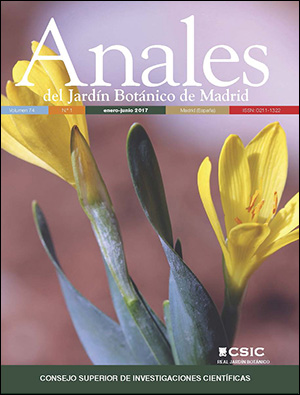Development and morphology of the fruit and seed of the hemiparasite genus Jodina (Cervantesiaceae)
DOI:
https://doi.org/10.3989/ajbm.2444Keywords:
Anatomy, Jodina rhombifolia, nectary disk, pseudodrupe, pyreneAbstract
The monotypic genus Jodina is endemic to central and southeastern South America, common in forests and scrubland environments. The fruit type in Jodina is controversial since it has been described at different stages of development. The main objective of this work was to analyze the morphology of the fruit of J. rhombifolia during its maturation to attain a consensus about its type. Also characteristics of seed development and anatomy were analyzed in detail. Material was processed according to conventional techniques for LM and SEM studies. The fruit of J. rhombifolia is a pseudodrupe since the ovary is half-inferior; the fleshy layer of the pericarp is constituted by an increase of the nectary disk whereas the stony layer is represented by the mesocarp. Participation of the nectary disk as part of the fruit wall has not been mentioned previously. The seed is “naked” —the integument disintegrates during development— and the resulting structure is a pyrene. The interpretations made by other authors on the fruit of Jodina are also discussed.
Downloads
References
Bhatnagar, S.O. & Sabharwal, G. 1966. Female gametophyte and endosperm of Jodina rhombifolia Hook. et Arn. Phytomorphology 16: 588-591.
Bhatnagar, S.P. & Sabharwal, G. 1969. Morphology and embryology of Jodina rhombifolia. Beitrage zur Biologie der Pflanzen 45: 465-479.
Bullock, D. & Moore, K. 1992. Protein and fat determination in corn. In: Linskens, H.F. & Jackson, J.F. (eds.), Seed analysis, pp. 181-197. Springer-Verlag Berlin Heidelberg. Berlin. https://doi.org/10.1007/978-3-662-01639-8_9 PMid:1611996
Cronquist, A. 1981. An integrated system of clasification of flowering plants, pp. 268-270. Columbia University Press. New York.
Dawson, G. 1944. Las santaláceas argentinas. Revista del Museo de La Plata, secc. Botánica 6: 5-80.
Der, J.P. & Nickrent, D.L. 2008. A molecular phylogeny of Santalaceae (Santalales). Systematic Botany 33: 107-116. https://doi.org/10.1600/036364408783887438
Dettke, G.A. & Caires, C.S. [2016]. Santalaceae. In: Lista de Espécies da Flora do Brasil. Jardim Botânico do Rio de Janeiro. [http://floradobrasil.jbrj.gov.br/jabot/floradobrasil/FB14411.] PMid:27108199
Fulcher, R. 1982. Fluorescence microscopy of cereals. Food Microstucture 1: 167-175.
Heide-Jørgensen, H.S. 2008. Parasitic flowering plants, pp. 104-105. Brill, Leiden. https://doi.org/10.1163/ej.9789004167506.i-438
Johansen, D.A. 1940. Plant microtechnique. Mcgraw-Hill, New York.
Johri, B.M. & Agarwal, S. 1965. Morphological and embryological studies in the family Santalaceae. viii. Quinchamalium chilense Lam. Phytomorphology 15: 360-372.
Kooiman, P. 1960. On the occurrence of amyloids in plants. Acta Botanica Neerlandica 9: 208-219. https://doi.org/10.1111/j.1438-8677.1960.tb00651.x
Kuijt, J. & Hansen, B. 2015. Santalaceae. In: Kubitzky, K. (ed.), The families and genera of vascular plants. Flowering Plants, Eudicots, Santalales, Balanophorales 12: 143-164. Springer International Publishing, Cham.
Lorts, C.M., Briggeman, T. & Sang, T. 2008. Evolution of fruit types and seed dispersal: a phylogenetic and ecological snapshot. Journal of Systematics and Evolution 46: 396-404.
Lott, J.N.A. & Buttrose, M.S. 1978. Thin sectioning, freeze fracturing, energy dispersive x-ray analysis, and chemical analysis in the study of inclusions in seed protein bodies: almond, brazil nut, and quandong. Canadian Journal of Botany 56: 2050-2061. https://doi.org/10.1139/b78-245
Luna, M.L. & De la Sota, E.R. 2003. Estructura foliar de Jodina rhombifolia (Santalaceae) y sus variaciones en relación al área de distribución. Iheringia, série botanica: 58: 3-12.
Luna, M.L. & Giudice, G.E. 2005. Anatomy of the haustorium of Jodina rhombifolia (Santalaceae). Nordic Journal of Botany 24: 567-573. https://doi.org/10.1111/j.1756-1051.2004.tb01641.x
Nee, M. 1996. A new species of Acanthosyris (Santalaceae) from Bolivia and a key to the woody south american Santalaceae. Brittonia 48: 574-579. https://doi.org/10.2307/2807878
Nickrent, D.L., Malécot, V., Vidal-Russell, R. & Der, J.P. 2010. A revised classification of Santalales. Taxon 59: 538-558.
O'Brien, T.P. & Mc Cully, M.E. 1981. The study of plant structure, principles and selected methods. Thermacarphi, Melbourne.
Rodríguez Mattos, J. 1967. Santaláceas. In: Reitz, R. (ed.), Flora ilustrada catarinense 1: 1-18. Itajai.
Rogers, Z.S., Nickrent, D.L & Malecot, V. 2008. Staufferia and Pilgerina: two new endemic monotypic arborescent genera of Santalaceae from Madagascar. Annals of the Missouri Botanical Garden 95: 391-404. https://doi.org/10.3417/2006148
Roth, I. 1977. Fruits of angiosperms. In: Braun, H.J. & al. (eds.), Encyclopedia of plant anatomy. Borntraeger, Berlin-Stuttgart.
Roth, I. 1987. Stratification of a tropical forest as seen in dispersal types. tasks for vegetative science 17: 189. Springer, Dordrecht, Netherlands.
Sancho, G. & Otegui, M. 2000. Vascularization and secretory tissues in florets of Gochnatia polimorpha (Asteraceae, Mutisieae): evolutionary considerations. Phytomorphology 50: 172-179.
Spujt, R.W. 1994. A systematic treatment of fruit types. Memoirs of the New York Botanical Garden 70: 1-182.
Takhtajan, A. 1997. Diversity and clasification of flowering plants. Columbia Univ. Press.
Published
How to Cite
Issue
Section
License
Copyright (c) 2017 Consejo Superior de Investigaciones Científicas (CSIC)

This work is licensed under a Creative Commons Attribution 4.0 International License.
© CSIC. Manuscripts published in both the print and online versions of this journal are the property of the Consejo Superior de Investigaciones Científicas, and quoting this source is a requirement for any partial or full reproduction.
All contents of this electronic edition, except where otherwise noted, are distributed under a Creative Commons Attribution 4.0 International (CC BY 4.0) licence. You may read the basic information and the legal text of the licence. The indication of the CC BY 4.0 licence must be expressly stated in this way when necessary.
Self-archiving in repositories, personal webpages or similar, of any version other than the final version of the work produced by the publisher, is not allowed.















